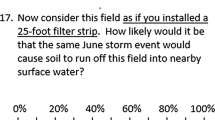Abstract
Insufficient sensitivity to scope (variations in the scale of the environmental good on offer) remains a major criticism of stated preference methods, and many studies fail a scope test of some sort. Across a range of existing explanations for insensitivity to scope (commodity mis-specification, embedding, warm glows) there seems to exist no clear conclusion on how to deal with the problem. This paper provides an alternative explanation for insufficient sensitivity to scope, based on re-definition of the determinants of value for environmental goods within an attributes-based choice model. In the proposed framework respondents’ Willingness To Pay need depend not only on physical characteristics of a good, but may also depend on the ‘label’ under which the environmental good is ‘sold’ in the hypothetical market. To investigate this problem, a Choice Experiment study of biodiversity was conducted. We find that controlling for the effects of a label—in this case, national park designation—leads to significant increase in the scope sensitivity of welfare measures.
Similar content being viewed by others
References
Adamowicz WL, Boxall PC, Louviere JJ, Swait JD (1999) Stated preference methods for valuing environmental amenities. In: Bateman IJ, Willis KG (eds) Valuing environmental preferences: theory and practice of the contingent valuation method in the USA, EC, and developing countries. Oxford University Press, New York
Andreoni J (1989) Giving with impure altruism: applications to charity and Ricardian equivalence. J Political Econ 97(6): 1447–1458
Arrow K, Leamer EE (1997) Comment no. 87, submitted to NOAA in response to advanced notice of proposed rulemaking (59 FR 1062, January 7, 1994)
Bartczak A, Lindhjem H, Navrud S, Zandersen M, Żylicz T (2008) Valuing forest recreation on the national level in a transition economy: the case of Poland. For Policy Econ 10(7–8): 467–472
Becker G (1974) A theory of social interactions. J Political Econ 82: 1095–1117
Bhat CR (1997) Covariance heterogeneity in nested logit models: econometric structure and application to intercity travel. Transp Res Part B Methodol 31(1):11–21
Birol E, Karousakisb K, Koundouric P (2006) Using a choice experiment to account for preference heterogeneity in Wetland attributes: the case of cheimaditida Wetland in Greece. Ecol Econ 60: 145–156
Blamey RK, Bennett JW, Louviere JJ, Morrison MD, Rolfe J (2000) A test of policy labels in environmental choice modelling studies. Ecol Econ 32(2): 269–286
Brouwer R, Langford IH, Bateman IJ, Turner RK (1999) A meta-analysis of Wetland contingent valuation studies. Reg Environ Change 1: 47–57
Carson RT (1997) Contingent valuation and tests of insensitivity to scope. In: Kopp R, Pommerhene W, Schwartz N (eds) Determining the value of non-marketed goods: economic, psychological, and policy relevant aspects of contingent valuation methods. Kluwer, Amsterdam
Carson RT, Mitchell RC (1995) Sequencing and nesting in contingent valuation surveys. J Environ Econ Manag 28: 155–173
Carson RT, Hanemann WM (2005) Contingent valuation. In: Mäler KG, Vincent JR(eds) Handbook of environmental economics. Elsevier, Amsterdam
Chilton SM, Hutchinson WG (1999) Some further implications of incorporating the warm glow of giving into welfare measures: a comment on the use of donation mechanisms by Champ et al. J Environ Econ Manag 37(2): 202–209
Cooper P, Poe GL, Bateman IJ (2004) The structure of motivation for contingent values: a case study of lake water quality improvement. Ecol Econ 50(1–2): 69–82
Diamond PA, Hausman JA (1994) Contingent valuation: is some number better than no number. J Econ Perspect 8(4): 45–64
Goldberg I, Roosen J (2007) Scope insensitivity in health risk reduction studies: A comparison of choice experiments and the contingent valuation method for valuing safer food. J Risk Uncertain 34(2): 123–144
Gunn AS (1980) Why should we care about rare species. Environ Ethics 2: 17–37
Hanemann MW (1982) Applied welfare analysis with qualitative response models. University of California, Berkeley
Hanley N, Wright R, Adamowicz V (1998) Using choice experiments to value the environment. Environ Resour Econ 11(3): 413–428
Hanley N, MacMillan D, Patterson I, Wright RE (2003) Economics and the design of nature conservation policy: a case study of wild goose conservation in Scotland using choice experiments. Anim Conserv 6(02): 123–129
Heberlein TA, Wilson MA, Bishop RC, Schaeffer NC (2005) Rethinking the scope test as a criterion for validity in contingent valuation. J Environ Econ Manag 50(1): 1–22
Hensher DA, Greene WH (2002) Specification and estimation of the nested logit model: alternative normalisations. Transp Res Part B Methodol 36(1): 1–17
Horne P, Boxall PC, Adamowicz WL (2005) Multiple-use management of forest recreation sites: a spatially explicit choice experiment. For Ecol Manag 207(1–2): 189–199
Jacobsen JB, Thorsen BJ (2008) Where to put a national park and what to put in it? An a priori study of the willingness-to-pay for coming national parks. University of Copenhagen, Copenhagen
Jacobsen JB, Boiesen JH, Thorsen BJ, Strange N (2008) What’s in a name? The use of quantitative measures versus ‘Iconised’ species when valuing biodiversity. Environ Resour Econ 39(3): 247–263
Johansson-Stenman O (1998) The importance of ethics in environmental economics with a focus on existence values. Environ Resour Econ 11(3–4): 429–442
Kahneman D, Knetsch JL (1992) Valuing public goods: the purchase of moral satisfaction. J Environ Econ Manag 22: 57–70
Kahneman D, Tversky A (2000) Choices, values, and frames. Cambridge University Press, Cambridge, UK
Krinsky I, Robb AL (1986) On approximating the statistical properties of elasticities. Rev Econ Stat 68(4): 715–719
Lancaster K (1966) A new approach to consumer theory. J Political Econ 84: 132–157
Lehtonen E, Kuuluvainen J, Pouta E, Rekola M, Li C-Z (2003) Non-market benefits of forest conservation in southern Finland. Environ Sci Policy 6(3): 195–204
Louviere JJ, Hensher DA, Swait JD (2006) Stated choice methods: analysis and applications. Cambridge University Press, Cambridge
McClure SM, Li J, Tomlin D, Cypert KS, Montague LM, Montague PR (2004) Neural correlates of behavioral preference for culturally familiar drinks. Neuron 44: 379–387
McFadden D (1974) Conditional logit analysis of qualititative choice behaviour. In: Zarembka P(eds) Frontiers in econometrics. Academic Press, New York
Nielsen AB, Olsen SB, Lundhede T (2007) An Economic Valuation of the Recreational Benefits Associated with Nature-Based Forest Management Practices. Landsc Urban Plan 80: 63–71
Olson M (1965) The logic of collective action. Harvard University Press, Harvard
Park T, Loomis JB, Creel M (1991) Confidence intervals for evaluating benefits estimates from dichotomous choice contingent valuation studies. Land Econ 67(1): 64
Poe GL, Giraud KL, Loomis JB (2005) Computational methods for measuring the difference of empirical distributions. Am J Agric Econ 87(2): 353–365
Rescher N (1980) Unpopular essays on technological progress. University of Pittsburgh Press, Pittsburgh
Ritov I, Kahneman D (1997) How people value the environment. In: Bazerman M, Messick D, Tenbrunsel A, Wade-Benzoni K (eds) Environment, ethics, and behavior. New Lexington Press, San Franciso
Roe B, Haab T (2007) Using biomedical technologies to inform economic modeling: challenges and opportunities for improving analysis of environmental policies. Paper presented at the Frontiers in Environmental Economics Conference. Washington, DC
Rolston H (1988) Environmental ethics: duties to and values in the natural world. Temple University Press, Philadelphia
Rossiter JR, Percy L (1997) Advertising communications and promotion management. McGraw Hill, Sydney
Russow LM (1981) Why do species matter?. Environ Ethics 3: 101–112
Scarpa R, Rose JM (2008) Design efficiency for non-market valuation with choice modelling: how to measure it, what to report and why. Aust J Agric Resour Econ 52(3): 253–282
Smith VK, Osborne LL (1996) Do contingent valuation estimates pass a “Scope” test? A meta-analysis. J Environ Econ Manag 31(3): 287–301
Street DJ, Burgess L, Louviere JJ (2005) Quick and easy choice sets: constructing optimal and nearly optimal stated choice experiments. Int J Res Mark 22(4): 459–470
Author information
Authors and Affiliations
Corresponding author
Rights and permissions
About this article
Cite this article
Czajkowski, M., Hanley, N. Using Labels to Investigate Scope Effects in Stated Preference Methods. Environ Resource Econ 44, 521–535 (2009). https://doi.org/10.1007/s10640-009-9299-z
Received:
Accepted:
Published:
Issue Date:
DOI: https://doi.org/10.1007/s10640-009-9299-z




